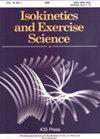Trunk muscle activity while lifting objects of expected and unexpected weight in normal subjects and patients with low back pain
IF 0.7
4区 医学
Q4 ENGINEERING, BIOMEDICAL
引用次数: 0
Abstract
BACKGROUND: Lifting heavy objects can induce postural stress and low back pain. OBJECTIVE: This study aimed to examine the effect of object weight expectations on trunk muscle activity and assess trunk muscle activity in people with chronic low back pain. METHODS: Twenty-two male college students (11 healthy and 11 participants with chronic low back pain) were recruited. The procedure was performed in three settings: lifting an expected 5-kg object, lifting an unexpected 10-kg object, and lifting an expected 10-kg object. Lifting was divided into five phases, and the muscle activity in each phase was compared between groups (chronic low back pain/control), object weight predictions, and phases. RESULTS: Compared to the control group, the chronic low back pain group had higher erector spinae muscle activity, regardless of weight or prediction, and significantly higher rectus femoris muscle activity in the early lifting phase of the expected 10 kg object (p= 0.043). Compared to when lifting the expected 10 kg object, erector spinae muscle activity was higher in the early lifting phase of the control group when lifting the unexpected 10-kg object (p= 0.016). CONCLUSIONS: Healthy individuals and individuals with chronic low back pain had different recruitment strategies for lifting objects heavier than predicted.正常受试者和腰痛患者在举起预期和意外重量物体时的躯干肌肉活动
背景:举起重物会引起体位压力和腰痛。目的:本研究旨在检验对象体重预期对慢性腰痛患者躯干肌肉活动的影响,并评估其躯干肌肉活动。方法:招募22名男大学生(11名健康人和11名慢性腰痛患者)。该程序在三种情况下进行:举起预期的5公斤物体、举起预期的10公斤物体和举起预期的十公斤物体。举重分为五个阶段,并在各组(慢性腰痛/对照组)、物体重量预测和阶段之间比较每个阶段的肌肉活动。结果:与对照组相比,无论体重或预测如何,慢性腰痛组在预期10 kg物体的早期举起阶段都有更高的竖脊肌活动,股直肌活动显著更高(p=0.043),对照组在举起意外的10公斤物体时,早期举起阶段的竖脊肌活动较高(p=0.016)。结论:健康个体和慢性腰痛个体在举起比预测更重的物体时有不同的补充策略。
本文章由计算机程序翻译,如有差异,请以英文原文为准。
求助全文
约1分钟内获得全文
求助全文
来源期刊

Isokinetics and Exercise Science
医学-工程:生物医学
CiteScore
1.20
自引率
14.30%
发文量
37
审稿时长
>12 weeks
期刊介绍:
Isokinetics and Exercise Science (IES) is an international journal devoted to the study of theoretical and applied aspects of human muscle performance. Since isokinetic dynamometry constitutes the major tool in this area, the journal takes a particular interest in exploring the considerable potential of this technology.
IES publishes studies associated with the methodology of muscle performance especially with respect to the issues of reproducibility and validity of testing, description of normal and pathological mechanical parameters which are derivable from muscle testing, applications in basic research topics such as motor learning paradigms and electromyography. The journal also publishes studies on applications in clinical settings and technical aspects of the various measurement systems employed in human muscle performance research.
The journal welcomes submissions in the form of research papers, reviews, case studies and technical reports from professionals in the fields of sports medicine, orthopaedic and neurological rehabilitation and exercise physiology.
 求助内容:
求助内容: 应助结果提醒方式:
应助结果提醒方式:


